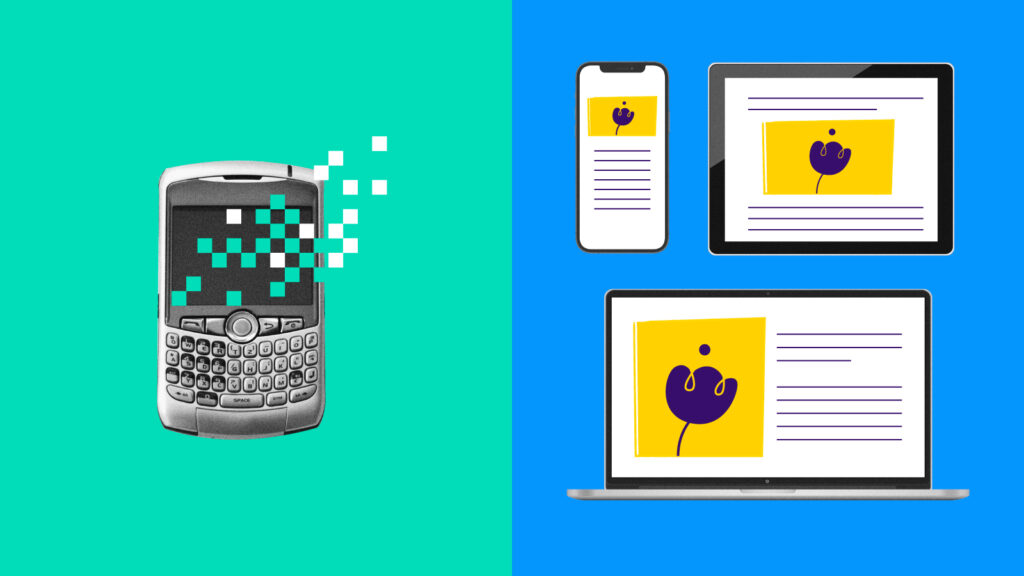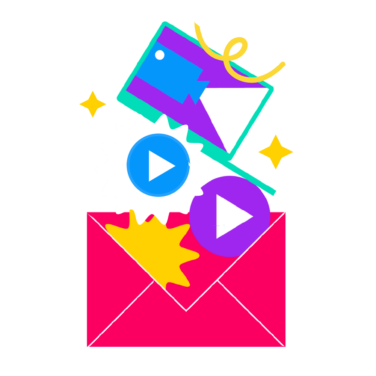With interactive content, the quintessential value of the internet comes full circle.
Remember when we were first taught the definition of “internet” in the 1990s? It was introduced as an “interconnected network” of computers. In retrospect, one now realizes how the “internet” was always steering to connect people—the consumers of all content available on the internet—not just to each other but to the content itself.
Having experienced the transition from print media to digital media in the publishing sphere firsthand, I can confirm that interactive content is now the only logical way forward for content creators to connect with consumers today—those that are always on the go with a smartphone handy, but no time to sit back and enjoy the leisure of a good old paperback!
As a people, we have transitioned from enjoying leisure daily to appreciating leisure only on vacations and holidays. This has also changed the way we consume content and the patterns of audience engagement. The mere existence of the beautiful abbreviation “TL;DR” drives home the point I am trying to make. We like our content like we like advertisements—informative with incentives and in short bursts of time.
Let’s take a look at how interactive content fits in with our new reading and research habits and what examples of interactive content can help boost your media brand loyalty.
What Is Interactive Content?
I remember, as a student on a budget, reading downloaded PDFs of books on a tiny smartphone (and sometimes a desktop), and the sheer ennui of zooming in and out a thousand times to get through one paragraph is inexplicable.

Who had thought that soon we would have e-books and interactive flipbooks that would be congruent with myriads of devices?
That is what interactive content does. It makes us, the consumers of content, participants in the content we experience. Interactive content has made the otherwise passive act of content consumption an active experience for the users who get to choose how they interact with the content at their disposal.
What Are The Benefits of Interactive Content?
Interactive content combines content and experience
Have you taken quizzes to check which character from one of your favorite TV shows you most resemble? Or, more recently, have you taken quizzes to find out which shampoo would suit your hair type best or which foundation would be perfect for your skin tone?
This is how you participate in and interact with content to finally end up learning something for yourself—be it your resemblance to a character or the best products curated just for you!
Interactive content combines information and experience for its users. Content published in the form of interactive e-books, quizzes, infographics, and videos makes for a journey for the users; they spend time with the content instead of just getting through it.
What does it do for publishers and content creators, though?
Publishers, writers, media brands, and artists thrive on the participation of consumers in their content. And now, with the internet at people’s fingertips, interactive content has made it possible for content creators and media publishers to decide for themselves and choose how they would want their consumers to become active “characters” in their content.
For content creators, there is no bigger joy than seeing how the target audience interacts with and reacts to the content curated just for them in real time, as opposed to just leaving the content out there to its own fate.
Interactive content increases engagement
Content on digital media needs to be created catering to the time and attention span of the users today who want snapshots of information to quickly bring them up to speed.
Given this parameter, interactive content comes in as an opportunity for designers and content creators to come up with formats that promise increased engagement. Engagement with content on the terms of the consumer is what builds the relationship between readers and publishers/content creators and promises increased consumer loyalty.
Content consumers today are used to intuitive formatting that allows them to view content set in a flexible-cum-customizable format on an array of devices.
Moreover, with the kind of social media access that we are used to today, most of the learning and reading happens from the timelines (or feeds) on these channels. So, the ability to access content online that can be shared to social media channels, saved for reading at leisure or bookmarked for future reference not only makes for an enjoyable reading experience but also keeps the consumer engaged for longer.
Additionally, it is this increased engagement brought about by interactive content that becomes the ultimate marketing solution for the content itself, finally translating into leads, sales, and revenue.
Interactive content generates more user feedback
One backhanded advantage of interactive content is the superabundant inflow of feedback from real consumers in real time!
Static content does not give you feedback in real-time, nor does it tell you how many consumers “actually” engaged with your content. But interactive content has completely turned the tables; feedback is generated as the consumer engages with the content.
Every click, every view, and every interaction with your content converts into points of data for you to keep track of, use to improve and update your interactive content, and revamp as required to keep the consumers engaged and involved.
The data collected also tracks exit points for different users allowing you to understand your audience in greater detail—what subject interests them and up to which point. This understanding and the ability to play within this understanding is what would ultimately keep us in the game.
What Types of Interactive Content Can You Produce?
1. Quizzes
Quizzes and assessments are already the most popular format for interactive content, especially after all that buzz around the BuzzFeed quizzes.
With their catchy and quirky phrasing, interactive quizzes not only keep the participants engaged but also market the content, brand, and often a product well. Based on the result, the quizzes can lead site visitors to affiliate links or be used as points to collect data which can lead to potential sales and revenue.
Additionally, given the milieu of social media, the results could be made shareable on feeds and timelines, which would generate more consumers/readers for the content. That is what this quiz on Buzzfeed about grammar does while brushing up the grammar of its (and NOT it’s) readers/participants.

2. Videos and animations
School education has already changed a lot in the last decade.
Most leading publishing houses give digital assets with their print books to keep students engaged. Videos and animations are a huge percentage of these digital assets, especially in English Language Teaching.
Stories and poems in print are adapted into short animations for students as an alternative way of engaging with the content of the book.
However, we can now make this visual content interactive by introducing clickable options. Explore how this would add to your content engagement, as opposed to passive viewership.
YouTube already gives the option to create interactive videos, and there are many such videos out there. People even use them as an alternative to games, such as the games on YouTube for the popular show Squid Game.
The famous Netflix film Black Mirror: Bandersnatch already had a crushing impact on its viewers, who were suddenly responsible for taking the plot further.
Releasing such short and interactive videos/animations could serve as an antecedent to long-form content that you want to release or a follow-up after the release to engage with your audience or readers.
And these would work just as well with long-form content that is not even in the same format.
3. Calculators and other tools
Calculators are excellent interactive tools for engagement, lead generation, and capturing data of potential customers. That is how content marketing principles strategized to use these tools; take a look at the interactive calculator options Outgrow provides.
As content publishers and writers, we can find ways how such tools would help consumers engage more with our content. So, a timer at the end of a quiz or a calculator to show how long one engaged with a piece of content, in congruence with the average time spent by people, can be a great example. A simple clickable “try again” button prodding users to better their score with respect to the average score is the push people sometimes need.
In ed tech, such a tool could allow students on a Learning Management System (LMS) to see how they score on quizzes and games in comparison to their classmates, which would also boost them to learn more and try again. This would also help teachers gauge how students perform based on the data they get from student interaction on the LMS.
4. Games
Gamification of content, narratives, and learning has recently challenged and completely changed the traditional way of delivering, teaching, and learning content.
Imagine a solid plot where the lead character, who becomes the reader/player in a gaming experience, is constantly faced with diverging options that would lead the story further—somebody like Dostoyevsky’s Raskolnikov standing on the screen thinking about the murder of Alyona Ivanovna when two options appear asking him to confess the guilt or go on denying it and losing his sanity over it.
Now imagine a much simpler game where the reader/viewer/participant is a driver in a racing game, and each crash or speed bump presents him with a problem that needs to be solved or answered. Even such a simple game would make space for maximum engagement with the content.
5. Maps
Imagine if you were writing a piece of fiction set in an imaginary world—much like J.R.R. Tolkien’s Middle Earth. Great, right?
Now imagine having a three-dimensional virtual map of the world you have created for your readers to interact with and find out what happened and where. This would create a far more immersive experience for your audience, with clickable pop-ups on the 3-D interactive map to follow everything more closely and become a part of the plot as it unfolds!
Maps make fictional settings a much more real experience for their readers, who become participants, almost characters, in the narrative. They have the agency to look at that world from the eyes of the omnipresent narrator or more closely at a character or a sub-plot line they want to follow as the reader.

Interactive maps are already set to take the world of ed tech by storm.
Look at this interactive map maker by National Geographic.
As students who need visual input to understand directions, spaces, and places, such interactive maps are just the format they need. In addition to sensory indulgence, these maps also provide engagement via participation to understand geographies and how they work through pop-ups, zooming features, and scrollability.
6. Ebooks
After an era of passive content and static PDFs, eBooks came in as a breath of fresh air, and these truly are the trump card in interactive content publishing.

Not only are ebooks easily accessible on an array of devices, but we can also actually embed most other interactive elements, such as audio, video, animation, games, quizzes, interactive infographics, and others, on these ebooks themselves.
So everything that you would want to package with a book is there all in one place. Therefore, an ebook is a one-stop shop that makes the user experience interactive and enjoyable.
And it does not hurt us, as content creators and digital publishers, that we can send out updates and revisions to these electronically—no need to pulp the existing stock for reprints!
4 Tips to Start Producing Interactive Content
It is easy to get lost in strategizing interactive content to such an extent that marketing campaigns and sales results start taking over. However, it is crucial to remind yourself as a content creator/digital media publisher that there is no experience without content.
And we need to create engaging content that has value and merit at its inception. That is what keeps us in business, doesn’t it?
1. Content, content, content
All online publishing starts with this. Do your research and write the content with honesty and diligence.
It is understandable that sometimes we might want to go for colloquial and quirky language when creating content for interactive formats. However, keep your target audience in mind—your vocabulary, sentence structure, grammar, syntax, and subject matter should be perceptive of your readers.
An excellent exercise while formulating content is to create a consumer persona, someone who would want your content and gain something out of it. This helps you ensure that the metal of your content resonates with the target readers/audience.
Make your content with the same diligence as you would a print product!
2. Study available interactive formats
Once you have your content, you can move on to exploring the various interactive formats available. Since technology is expensive, it would be a good idea to get your content reviewed by players in the industry and have an estimate of the sales before you make an investment.
Once you are ready, zero in on a format that would add to your content delivery. Ask yourself, “Should I create quizzes, or would mini-games engage my audience more?” Or, if you have a ton of assets to go with various sections of your content, maybe you should exploit the ebook format.
3. Technology partners
When you have a vision for your content and the interactive format you want, reach out to the various technology partners with digital publishing platforms and get quotes for the work you need them to help you out with.
An excellent exercise to ensure you get what you want would be to prepare PPTs with clickable slides to show how you want your content to engage and function with the readers and participants. This is an exercise to ensure the result is as close to what your vision was, to begin with.
Remember, as content creators, our creativity needs to be fed and used at regular intervals!
What if you are an independent content creator who does not have a lot of money to invest in technology? First of all, know that you are awesome, and don’t lose heart.
And then, explore all the DIY content creation tools available online for a low monthly fee or for free.
Gain access to these tools and play with your content on your own terms. (The next section has a list of tools you could explore!)
4. Collect data and optimize strategies
To test how your content works in the real world, release a trailer or a teaser of your content—it could be an engagement time of 30-45 seconds with your content, games, quizzes, or maps, after which the participant is prompted with a “buy now” button, or “share feedback.”
Use the data to strategize your content in line with your target audience, with feedback from marketing and sales teams in case you work for publishers.
What Are The Best Tools to Produce Interactive Content?
1. Thinglink
Create an array of digital assets ranging from interactive infographics, audio, video, and virtual tools to create augmented reality experiences.
Explore this option in the free 30-day trial period to see how you could revamp your content with Thinglink.
2. Cleverstory
This is another simple yet creative option for interactive content creators.
Book a demo to see how the software would personalize the content experience and interactive experience for the readers/participants.
3. Outgrow
This is an excellent option for those looking at quizzes, assessments, calculators, contests, and surveys as interactive formats for their content or as additional elements to add to their content.
Try this option for free in case your content aligns with what they offer.
4. MapMaker by National Geographic
This allows you to create interactive maps for free.
5. FlippingBook
This is an online eBook creator that allows you to embed interactive videos, links, infographics, animations, etc., with the content you want to publish.
Try it for free or book a demo with them, for starters.
The Sky’s the Limit With Interactive Content
Get started on learning everything you can about interactive content and exploring the tools that are already out there.
Just get your hands dirty already because all of us are still trying to perfect this one! And while you are here, don’t forget to subscribe to the Indie Media Club.
More great IMC content:


